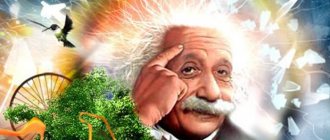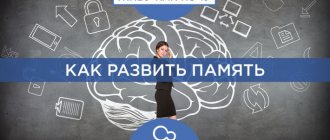Lack of imagination often worries people who are creative. Such individuals, due to their abilities and capabilities, have to constantly deal with work built on fantasy emotions.
The exercises, techniques and recommendations below will help you determine your creative abilities, discover your talent for writing articles or novels, stories, and improve the level of your writing imagination. Also, these exercises for developing imagination in children: preschoolers and teenagers, and adults.
What is it and how is it different from fantasy?
Imagination is a person’s ability to create images, ideas and ideas of objects based in reality in the head.
It is logical validity that distinguishes imagination from fantasy, which is a fictitious situation created by our consciousness. Fantasy does not correspond to reality, does not obey common sense, but only expresses human desires.
More than 100 cool lessons, tests and exercises for brain development
Start developing
Let me give you a simple example. Imagine a cat. Happened? Each of you got it in a different color and size. Some imagined a generalized image with four legs and ears, while others imagined a pet in the smallest detail. This is how your imagination worked. You have seen a cat in real life more than once, and therefore it was not difficult for you to recreate it in your head.
And now another experiment. If you are asked to come up with an unusual animal, you will begin to fantasize, that is, to compose. Your ideas will not be based on past experience, physical laws and other knowledge. You can compose anything, there are no restrictions. This is what is called fantasy.
Find out what role imagination plays in remembering.
What is imagination for?
Many people believe that imagination is necessary primarily for creative people: artists, composers, poets. But this is far from true. Imagination is the foundation of creative thinking. Without it, it would be impossible to dream, make plans, set goals, or enjoy beauty. Imagination is what distinguishes us all from the animal world.
Here are a number of other advantages that speak in favor of this ability:
- Expands the boundaries of what is possible. If you set goals only on the basis of already acquired experience, you will not be able to reach new heights and boundaries.
- Gives the world inventions. People dreamed of flying like birds and came up with an airplane. They fantasized that they would one day be able to talk with loved ones who were far away, and they created the telephone. All the things around us that seem familiar were once created by someone’s imagination.
- Helps solve problems in innovative ways. Instead of doing things as usual, we can use creativity and find a new and unusual way out of the situation. Sometimes he turns out to be brilliant and makes life much easier.
- Leads to discoveries. For example, Albert Einstein dreamed of a place where it would be possible to stop time and capture the best moments of his life. His thoughts led to the creation of the general theory of relativity, without which humanity would still consider time to be a constant.
- Allows you to create. It was imagination that contributed to the creation of the Marvel universe, famous musical compositions, majestic skyscrapers, designer clothes, etc. Without someone's imagination, there would not even be fairy tales and games in our childhood.
- Gives you the opportunity to admire the beauty of the world. Ever heard the phrase “Blows the mind”? This is what they say about the deep starry sky, endless mountain landscapes, and the rippling surface of the sea. A person who is not endowed with creative imagination will not spend a long time watching a fire burn or a waterfall flow, because from a practical point of view it is meaningless.
Scientists say that imagination helps create new neural connections in the brain. Due to this, a person is able to influence not only his own habits and actions, but also create the desired reality around himself. Read more about this feature of imagination in the article about what visualization is.
Contents of the exercise
The presenter uses gestures, facial expressions, and sounds to depict some object (train, car, teapot, duck, plane, Christmas tree, ice cream, light bulb, etc.) or some action (washing, combing, drawing, swimming, singing).
The rest of the children in the group must guess what object or action the leader is depicting. The one who guessed the driver's intention becomes the leader. The game continues several times.
Exercise 5. “Draw by dots”
Target.
Develop children's imagination and spatial perception.
How it happens
There are several classifications. I will give the most common ones.
According to the degree of purposefulness, the following types of imagination are distinguished: active and passive.
Active stimulates a person to create, allows him to create something new in professional and creative activities. It is divided into:
- Reproductive. It is a recreation of real images based on lived experience.
- Productive (or creative). Images are created according to their own design, almost without recourse to experience.
Passive does not have the goal of realizing invented ideas. It comes in two forms:
- Involuntary. It is an unintentional imagination that can be difficult or impossible to control. This includes random thoughts, dreams, hallucinations.
- Arbitrary. It is controllable and is associated primarily with unlikely or incredible predictions for the future. These are our dreams and dreams.
Contents of the exercise
The presenter informs students that on a clock with a dial, you can swap the hands. At the same time, the time will also change accordingly. So, for example, if the clock showed ten o'clock, then after changing the hands, the clock will show 11 hours 50 minutes (can be demonstrated on a model or board). Using their imagination, students must answer what time the clock will show after changing the hands:
- 5 minutes to 12
- 10 hours 11 minutes
- 2 hours 31 minutes, etc.
Target.
Develop creative imagination
Techniques for developing imagination in adults
Everyone has an imagination. It’s just that for some it is well developed, while for others, due to a logical mindset, it is relegated to the background and needs to be “stirred up”.
Let's consider what you need to do to stimulate the development of imagination:
- Replace watching TV with a suitable hobby. Serials and television shows are a type of passive recreation that does not involve mental and creative effort. But any creative activity perfectly develops the imagination and at the same time makes you happier. It is by no means necessary to be an expert in drawing, sculpting or writing poetry - create for your own pleasure. But you can read about how to develop creative abilities in our separate publication.
- Listen to music without words. Ready-made song lyrics inspire us with other people's thoughts. Even when we listen to songs in a language unfamiliar to us, it still limits the scope for thought. Collect a selection of a wide variety of melodies and try to choose your own words or images for them. It is better to use blues, jazz or classical music for this. But here, as they say, it’s a matter of taste. By the way, you can also try watching movies without sound, trying to understand what they are talking about.
- Read books of different genres. Fiction and fantasy are especially useful for the imagination.
- Keep a diary. You can write down any interesting thoughts there, make up stories, or simply tell how your day went. Writing greatly stimulates the imagination and flight of thoughts.
- Get new experiences. Go to exhibitions, visit museums, communicate with interesting people, replace your usual routes with new ones, study, travel.
- Don't be shy to dream. Dreams are not just the prerogative of little children. It is also useful for adults to fantasize about a bright future. This will relieve boredom and develop imagination.
Here are a few problems.
Task No. 1. Imagine in your mind a triangle, each side of which is 2 meters. Now, from the base of this triangle, mentally draw a line to the right, another 2 meters. Then draw exactly the same line to the right of the vertex parallel to the first one and connect their ends to each other. What kind of figure did you get? Just no notepads! Use only your imagination.
Task No. 2. This exercise will require a self-test. Below I will name the words, and you must imagine them in your head. You need to assign a point to each image:
- if there is no image at all – 0;
- if it is weak - 1;
- good image – 2;
- very bright and distinct – 3.
So, the words will be divided into several categories:
- Visual images – car, sparrow, cherry, supermarket.
- Auditory - a barking dog, a school bell ringing from class, rumbles of thunder.
- Tactile - cat fur, wind, ladybug crawling on the hand.
- Olfactory – strawberries, freshly cut grass, garlic, fire.
You can add any images to the categories provided.
Before performing the next exercise, I advise you to read about what associations are.
Task No. 3. You need to match association objects to different colors. For example, when you hear “purple,” what comes to mind? Perhaps it’s an eggplant, a car that color, a shade of the rainbow, etc. What about orange, gray, burgundy? Select as many objects or phenomena as possible.
Task No. 4. Droodles will help us. These are graphic puzzles, which are conventional images that need to be drawn into a meaningful object. This can be done either alone or in a group.
How the process can happen:
- Each player takes turns giving their version of what is shown in the picture. Those who do not have a version are eliminated from the game. The action continues until there is only one winner left.
- One player-leader draws a graphic template and invites the other participants to come up with a continuation. The one with the most ideas wins.
Below I have given an example of what droodles look like.
Perform developmental exercises from Ikyusha
Mathematics
Reading
The world
Logics
English language
Anagrams
Age: from 5-6 years
Anagrams are the rearrangement of letters in a word to form a new word. For example, sleep is nose, rakask is paint. Anagrams work well for children who can already read.
Such tasks increase concentration and speed of thinking, and also develop visual memory.
Schulte tables
Age: from 5 years
Many parents have heard about Schulte tables. These exercises are very popular as they increase concentration and develop memory in a light playful way. The child’s task is simple - to find in order the numbers or letters randomly located in the table. The sizes of the table vary depending on the age and preparation of the baby (usually from 3x3 to 16x16).
Exercise “Listen and count”
Age: 6-8 years
Another great exercise for focusing attention. You read the sentence while tapping your pencil or pen on the table. The child needs to remember both the text and the number of your strokes. If the baby begins to cope easily, complicate the task by gradually increasing the number of blows.
Methods and exercises for children
Children primarily copy the behavior of adults. Therefore, if you want to develop imagination and fantasy in your child, then cultivate these abilities in yourself. Here are some recommendations:
- Read books with a fantastic plot with your child, and then discuss the details, ask what the characters might look like if the child himself drew them. Teenagers can be invited to read the works of Jules Verne and the Strugatsky brothers.
- Ask unusual questions. For example, ask what supernatural ability the child would like to be endowed with or what animal, in his opinion, is missing in nature. What will happen if electricity disappears forever or people live underwater and fish live on land?
- Ask how a child's life would change if he suddenly became the size of a pencil or, conversely, became as big as a giant. Let him fantasize and tell him how his normal day might go.
- Invite your child to imagine himself as a plant, a stone, a bird, a dinosaur, a shark, an insect, etc. Ask questions about how he feels, what desires he has, what or who he is afraid of, etc.
- Turn on a cartoon that the child has not yet watched and ask him to voice it at random. By the way, you can take on the roles of different heroes and train together.
Contents of the exercise
Children are given the beginning of a fairy tale or story. Their task is to continue the story and come up with its ending.
Story options:
A) Once upon a time there was a doctor in the countryside. He often went to see sick people in other villages, but he didn’t have a dog in the house. Therefore, he was always worried about his property.
One day the doctor decided to leave an inkwell to guard the house.
Just at this time a thief decided to break into the house. He climbed over the fence, opened the door, and...
B) For the New Year, a beautiful and lush Christmas tree was put up in the house. A bright red star was hung on the top of the forest beauty. The children helped decorate it with colorful balloons, confetti, glass and paper toys. The most interesting thing is that at night all the toys came to life, they could talk, laugh and even run, jump and scream. And so on New Year's Eve, when everyone went to bed, the toys began to move and began to have their own casual conversation about all sorts of nonsense. And suddenly their attention was attracted by an incomprehensible noise in the very corner of the room...
Exercise 3. “Unnecessary object”
Target.
Develop creative thinking and imagination of children.
Useful materials on the topic
In conclusion, here is a small selection of literature for those who want to delve deeper into the topic of imagination:
- Michael Mikalko “Rice Storm and 21 More Ways to Think Outside the Box”
- Michael Mikalko “Hacking creativity. How to see what others don’t see”
- Dan Roem "Visual Thinking"
- Asoskova Y., Kinyakina O., Zakharova T. “Brain 100%. Intelligence. Memory. Creative. Intuition"
- Christoph Niemann “Sketch on Sundays”
- Estanislao Bachrach “Flexible Mind”
- Mark Levy “Genius to order”
- Edward de Bono "Six Thinking Hats"
- Austin Kleon Steal Like an Artist. 10 Lessons on Creative Self-Expression”
- Marina Moskvina “Learn to see. Lessons from creative upswings”
- Jonah Lehrer “Imagine. How creativity works"
I also recommend the Course on the development of creative thinking from the Vikium platform. It will help not only develop imagination and attention, but also learn how to create and implement your ideas, and find non-standard solutions. The program consists of 16 lessons with videos, graphic diagrams and assignments. The cost of participation is 1,490 rubles.
Distinctive features of a child's creative imagination
The imagination of a preschooler, like all cognitive processes at this age, most often acts involuntarily. It is still inappropriate to talk about special plans and goals characteristic of the boundless flight of thought. But active imagination and the desire to try out many things from one’s own experience indicate the beginning of the development of creative imagination in preschool children. Signs of creativity are clearly visible.
- Brightness and originality of fantasies and images
Children create incredible stories in which they give toys or ordinary objects “magical” properties. This happens because preschoolers are immersed in the world of fairy tales and cartoons. They may imagine themselves as characters from a fairy tale and be creative in describing the character's strengths or frightening traits. In addition, the child’s experience is not sufficient to understand the phenomena of the world around him, and he himself comes up with explanations for them.
- Active use of well-known images in new conditions
Developing creative abilities, the child repeats himself less and less often and more often practices creating new images, placing fictional characters in different situations. For example, an older preschooler is able to compose several stories about a fairy-tale hero. The image of the hero is the result of the work of creative imagination, and numerous stories with his participation appear due to the growth in the content of the child’s creativity.
The imaginary plot is embodied in the drawing
The fact that a child’s idea of something often goes beyond the usual boundaries also speaks about creative imagination. So, when completing the task of drawing rain in a fairyland, children imagine it as a shooting star, candy or flower rain.










